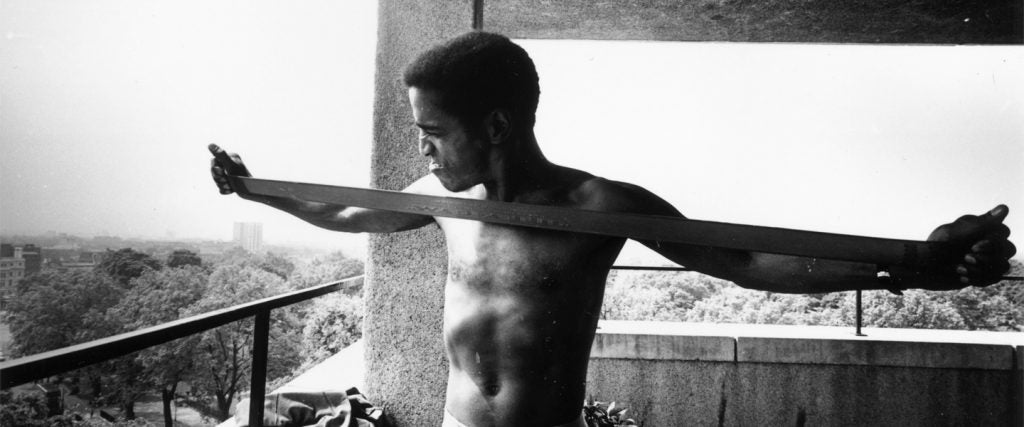In April 1895, the Pittsburgh Press reported of a visit to the city by Eugen Sandow, a man now hailed as the father of modern bodybuilding. During that visit, an 18-year-old bookkeeper named E.S. Hulsman was brought to Sandow for a thorough physical examination. Sandow was reportedly astonished by Hulsman’s development after only two years of training, having packed 16-inch biceps and a 42.5-inch chest onto a 5-foot-6, 136-pound frame.
Equally as remarkable was Huslman’s reported method of training. “He uses only lightweight dumbbells and Indian clubs, and a rubber exerciser of his own invention, which he has patented lately,” the Steel City paper explained. “The latter is a combination of head, leg, arm and waist movements, and is of great simplicity. After examining it, Sandow pronounced it one the most beneficial pieces of apparatus he has ever seen.”
Huslman’s invention was, of course, the earliest example of the resistance band, a training tool that joined yoga mats at the top of the fitness sales charts during quarantine, as millions of gym goers were forced to move their workouts into their bedrooms and living rooms. It was a moment the resistance band was tailor-made for: Their light weight, adaptable tension and easy storability making them particularly useful for at-home training.
It’s unknown what became of Hulsman’s product, although it can be inferred that he may have partnered with Sandow, or sold the intellectual property rights to the mighty Prussian outright. To that end, a few years later, Sandow was advertising an all-purpose pairing of dumbbells and rubber exercisers as his standard combination of endorsed training devices.
Still, in an era where an overwhelming majority of American workers earned their living through the callusing of their hands, some were resistant to the idea that rubber could be so effective at developing muscles. As a 1903 article in Iowa’s Davenport Democrat remarked, “There never was any patent rubber exerciser ever built that would put muscle onto arms as would the job of lifting a hoe about 23,000 times per working day of 14 hours.”
However, others who had firsthand experience with the devices were duly impressed. “There are no muscles of the body that are more readily developed than those of the shoulders, back and arms,” wrote middleweight boxing champ Bob Fitzimmons in a 1904 edition of the Scribner News. “A rubber exerciser such as can easily be fastened upon any door frame, a light pair of dumbbells and regular breathing exercises will accomplish the object.”
Obviously, not every rubber exercise machine was capable of standing the test of time. Some companies — like Bailey’s Rubber Store of Boston — produced one-dimensional training machines intended to emulate the motions of the common chores of the day. The result was a vertical rubber-based rowing device that looked profoundly silly and uncomfortable.
But in 1931, fitness titan Whitely would officially set its one-piece rubber-banded unit apart from all the rest. The “Jiffy Gym” took its position as the thick, elastic version of an exercise spring — i.e., the metal “chest expanders” that were popular at the time and that relied on steel coils to generate tension and resistance — that were also capable of being rolled up and stuffed into a pocket. Considering the relative paucity of exercises that were known to the general public back then, along with the great variety of muscle-building movements that could be performed with a set of exercise springs, the Jiffy Gym may have been the most effective fitness product in the world during its heyday.
Through the 1930s and 1940s, the Jiffy Gym was sold alongside many of the steel spring cables and similarly portable exercise devices that were holdovers from a bygone era. But as the decades wore on, more and more women began to gravitate toward elastic bands as their exercise equipment of choice. Actress Dorothy Lamour provided a direct endorsement for training with rubber bands in a 1945 New York Daily News article, and in the 1950s, elastic bands were even recommended to women as a solution for drooping shoulders in ads for Kotex sanitary napkins of all things.
In 1959, Whitely was acquired by the AMF-Voit Rubber Company, a move that absorbed Whitely within the company that developed the first-ever all-rubber athletic balls in history. The Jiffy Gym lived through the merger (even introducing the “Super Jiffy Gym” to target men with an even heavier and thicker resistance band), and managed to survive all the way until 1982 — or until elastic exercisers were implicated in a nationally syndicated article entitled “Mail-Order Fraud: How Modern Medicine Men Hawk Worthless Wares.”
Consumer editor Gwen Hall listed elastic bands right alongside vitamins, minerals, tablets, liquids, dainty dumbbells, muscle builders and hair growers as “schemes” that Americans were routinely falling prey to. She clearly didn’t realize that several generations of fervent trainees had been relying heavily on elastic bands as a primary source of resistance. Regardless, the Jiffy Gym was pulled from the market shortly thereafter, dying an ignominious death not befitting of a tool that had staked a claim to being the most prominent elastic training device in fitness history.
Thankfully, a full 40 years removed from the demise of the Jiffy Gym, we’ve learned from our mistakes, and its spirit lives on in the elastic bands that are now finally at the center of the home exercise world. In fact, the resistance-band market is projected to be worth $1.6 billion by 2025. And for once, such success is well-deserved. Because unlike many of their rival products, the truth behind what elastic bands can do for you has never needed to be stretched.

